The Dell XPS 15 9560 Review: Infinity Edge Part Two
by Brett Howse on July 31, 2017 8:00 AM ESTSystem Performance
Unlike some of the thin and light 15.6-inch devices that have been trickling out over the past while, which feature dual-core Ultrabook internals, Dell’s XPS 15 sticks to its heritage with a full quad-core processor with a 45-Watt TDP, and a discrete GPU in the NVIDIA GTX 1050. This is a lot more compute than any Ultrabook can achieve, and for those that need more oomph in their portable computing, the step up to a larger form factor device like the XPS 15 9560 could really help with a lot of productivity workloads.
Intel’s Kaby Lake processors have been a small step forward, with the same model 7 series CPUs offering higher frequencies than the 6 series counterparts. In the case of the review unit, that means the Core i7-7700HQ a few hundred MHz over the 6700HQ it replaces, with the latest model now offering a 2.8-3.8 GHz frequency range.
Dell also outfits the XPS 15 with 8 to 32 GB of DDR4, and a 500 GB to 1 TB HDD with 32 GB of Flash, or full PCIe NVMe SSDs in 256 GB, 512 GB, or 1 TB options.
To test system performance, the XPS 15 9560 was run through our standard laptop suite of tests. Comparisons in the graphs below are for similar systems, but you can compare the XPS 15 with any system we’ve tested using our Laptop Bench.
PCMark 8
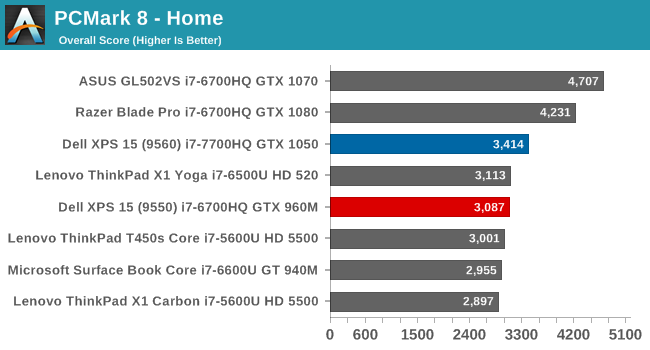

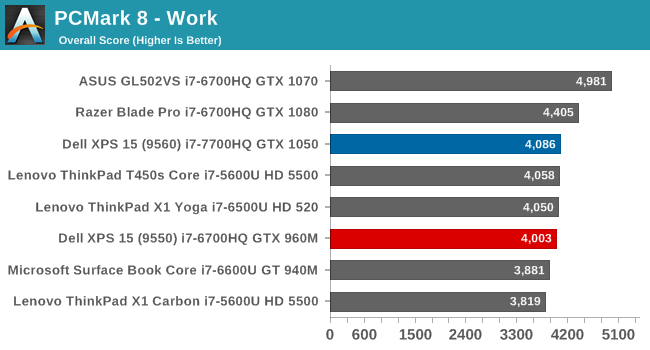
PCMark tries to simulate real-world tasks, and is broken into several categories which stress different parts of the system. All components of a laptop can impact the results, with the Creative and Home scores weighing heavier on the GPU capabilities for the gaming sections. Here the XPS 15 9560 pulls a sizeable lead over its predecessor mostly thanks to the updated graphics capabilities.
Cinebench
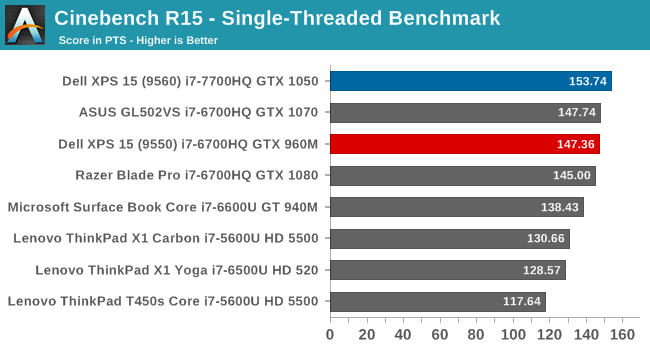

Cinebench is a CPU workload, where more cores and higher frequencies lead to better results. The test can be run as either a single thread mode, or in a multi-threaded mode where more cores can make a substantial impact. It’s clear in the multi-threaded results where the dual-core machines end and the quad-core ones begin, and the latest Kaby Lake chip in the XPS 15 9560 is able to surpass all of the Skylake based laptops it is pitted against.
x264
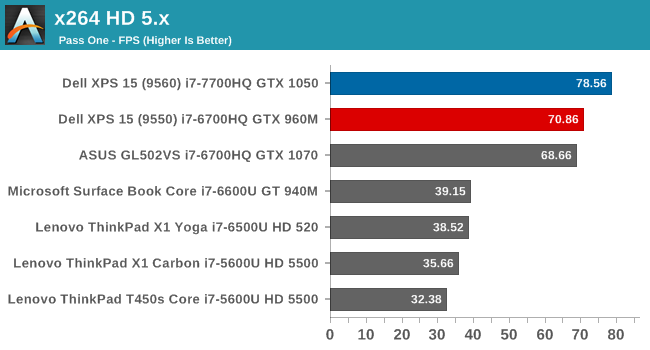

This test is similar to Cinebench, where pure CPU grunt is required, but without the single-threaded option. Once again, the Core i7-7700HQ shows it offers a noticeable increase in performance over the previous generation.
Web Performance
Web browsing is arguably the most important metric of all, but here the testing gets a bit murkier. Browser scripting performance is one of the key factors in web results, so it is important to be as consistent as possible here. We use Microsoft Edge as the browser, but even then, updates to the browser over time can increase performance, so these results are always a moment in time.
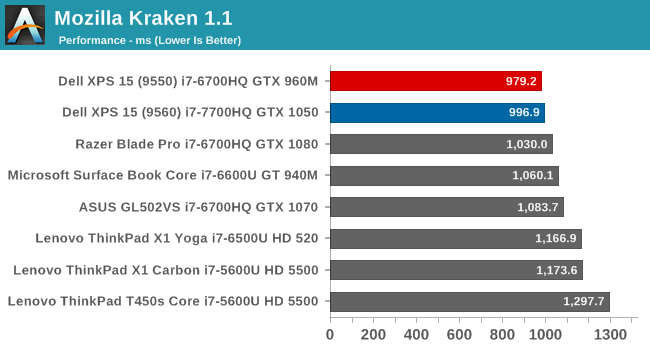
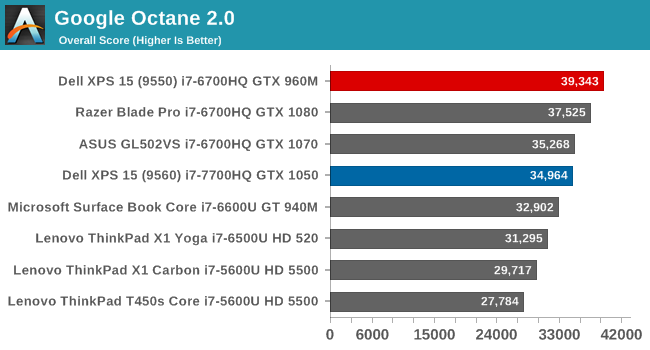
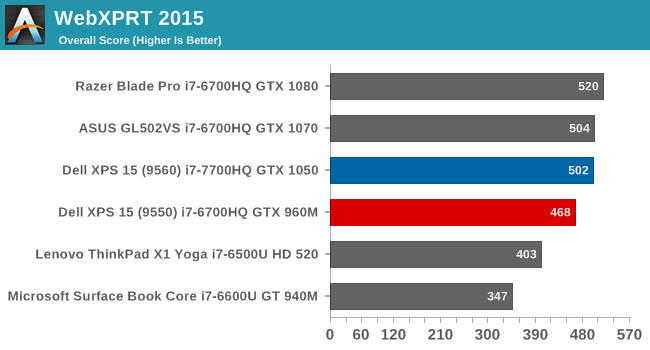
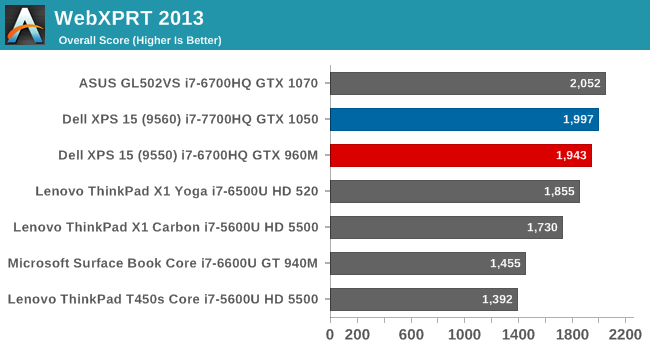
Although not right at the top in all of these scores, the XPS 15 9560 performs very well on any web task, and with the quad-core architecture, should offer more scripting performance than any Ultrabook for most tasks.
Storage Performance
The Dell XPS 15 9560 review unit shipped with a 512 GB PCIe NVMe SSD. Samsung is one of the most prolific OEM SSD providers, so it was a bit surprising to see a Hitachi based SSD in this XPS 15. This appears to be a XG4 based SSD from Toshiba with planar TLC. It’s far from cutting edge by today’s standards.
Looking at the performance, it is certainly a TLC based drive, with decent read speeds, and typical, poor, write speeds. Larger models may have better performance, and smaller models will almost certainly have a performance deficit to this version. As with most machines, these may be multi-sourced as well, so your mileage may vary based on the model you are looking at. Checking around at the 9560 owners threads on the web, it does appear that some are shipping with the Samsung PM961, which would be a nice step up from this drive if you’re lucky enough to get it.


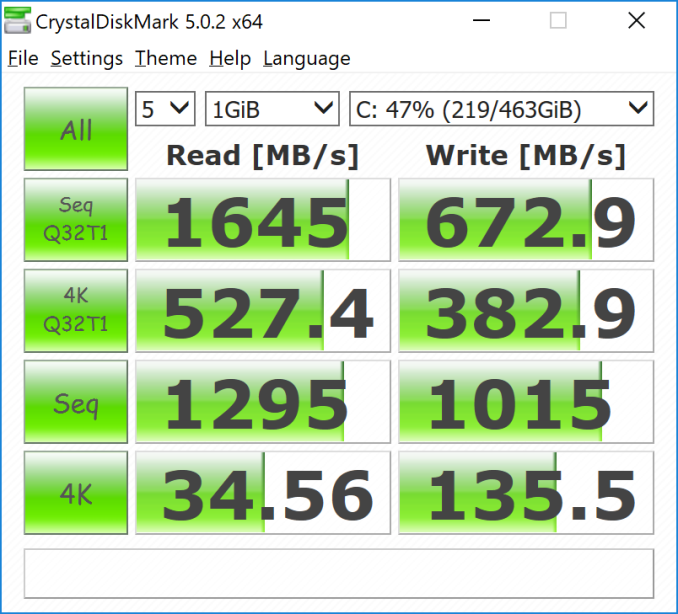








82 Comments
View All Comments
yetanotherraj - Monday, July 31, 2017 - link
"Near the end of 2015, Dell rolled out their new XPS styling queues" ... you mean "cues"?linster - Monday, July 31, 2017 - link
Where is this option to select the Intel WiFi card instead of Killer? Configuration tool on Dell's website isn't giving me an option to do this.petteyg359 - Monday, July 31, 2017 - link
I'd rather have the Broadcom chip in the Killer than Intel. Broadcom's Linux drivers actually work reliably, unlike Intel who was putting out buggy as hell drivers for their card in my L502x XPS 15. Several months of broken Wi-Fi and constant connection fails and dropping every two minutes in few rare success cases was great fun...Brett Howse - Monday, July 31, 2017 - link
Killer is based on Qualcomm not Broadcom.petteyg359 - Tuesday, August 1, 2017 - link
Yep. I appear to have been brainless yesterday. Point remains, just search and replace :) I'll take everything Atheros over Intel any day.Vatharian - Monday, July 31, 2017 - link
What is this 99 Wh limit you mention at the beginning of the article?tipoo - Monday, July 31, 2017 - link
You can't fly with more than a 100Wh battery, so most laptops are at most 99Wh.SaolDan - Monday, July 31, 2017 - link
Intel 6D 530?? HD?twtech - Monday, July 31, 2017 - link
I have the 9550, which has the same chassis & display with different internals. Overall, I like the laptop - I wish every manufacturer would use a similar layout that maximizes display size. But I've had quite a few issues with it, and I'm wondering if any of them apply to the 9560.One of the big ones was an issue with the integrated graphics drivers - I don't know if it was actually an overheating issue later mitigated by the updated drivers, or if the software was just buggy, but for quite a while the driver would crash and restart repeatedly. I thought the machine was damaged - turned out a driver update was all that was needed to fix it, but it took months to get it. That issue I assume has probably been fixed.
The spacebar on the keyboard may be impeded by the battery ribbon cable that runs underneath it, if the cable is at all loose. A loose battery cable sticks up a bit, it interferes with the spacebar, causing it to intermittently not register keypresses. This one could still be an issue for the 9560 if nothing has changed about the design or manufacturing process.
I also recently had an issue with battery swelling in my 9550. It manifested itself as an increasingly hard-to-click touchpad - it's probably actually a good thing that it did, because an expanding battery is an explosion risk otherwise. Searching for information on the ultimately-unusable touchpad led me to the source of the problem. Apparently the battery is susceptible to the issue if you leave the laptop plugged in most of the time. I self-replaced the battery which isn't very difficult - provided you have the right tool to remove the screws.
CubicleHermit - Monday, July 31, 2017 - link
Nice review. I've had mine for about two months now, and agree with almost everything you've said. The one exception is the absolutely awful time I had for the first few weeks with the Killer wireless card which among other problems would not connect to the EAP authenticated network at my work or work at all under Linux which I dual boot. Fortunately, unlike some other machines, the wireless card is still a plain M.2 card and was dead easy to replace with an Intel 8265 which works much better.The only annoyance opening the machine is the Torz TX5 screwdriver needed, and that is the same one as all of Dells other extrathin XPS and Precision models so it was easy to find.